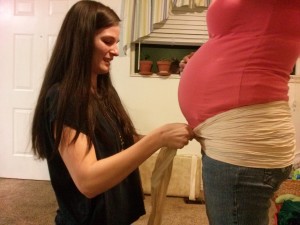
(Photo courtesy of Madison Lopez)
Students in Madison Lopez’ high school biology class cringed and shielded their eyes as they watched the final birthing scene of “The Miracle of Life,” but Lopez didn’t.
“I think it’s fascinating,” said Lopez, a BYU senior and exercise and wellness major. “There are just so many things that could go wrong with conception, but for how often it goes right and how often we’re born healthy, that is a miracle right there.”
Lopez is no stranger to bizarre looks and awkward reactions, especially when she tells people she’s a doula. Some of those looks subside when she explains that a doula is a birth coach, but there is a stereotype surrounding her chosen field that can prompt a hesitant reaction.
“People think that all doulas want you to have a natural birth, hate hospitals and will judge you if you want medical intervention,” Lopez said. “That’s just not true.”
Birth doulas typically meet with their clients a couple of times before the birth to get to know the parents and once postpartum to make sure everything is running smoothly.
Lopez was timid about taking on her first client as a doula. Her biggest fears lingered in her mind with every opportunity to jump into the field. She worried that a client might know more about birth than her, or even worse, lose the baby. These hypothetical “what if’s” quickly became a reality when Lopez took on her first two clients.
“One of my first clients knows so much about birth that it’s intimidating, and the other one recently lost her baby, ” Lopez said. “Now that I’ve experienced my biggest fears I feel like I’m ready to move on and be confident as a doula.”
Conquering significant fears is not the only hard part about being a doula. Andrea Lythgo, a seasoned doula from Sandy, said the anticipation of her client going into labor can take a toll on family relationships.
“It’s hard to live your life on-call,” Lythgo said. “When I leave to go to a birth, everything gets dumped on my husband, sometimes 40 hours at time. He’s got a job and business of his own, so it can be a challenge for both of us.”
The obvious drawbacks of the industry are not enough to keep Lopez from pursuing a career in the labor and delivery field. Someday she will be a midwife.
Midwives differ greatly from doulas because they play the primary role in delivering the baby. Debbie Edmonds, an assistant teaching professor in the College of Nursing, said she has noticed a growing trend in the use of nurse midwives among laboring women.
“Most of the women who use a midwife are a little bit more interested in the personalized care and might be interested in going unmedicated,” Edmonds said. “Midwives in general tend to be more supportive of alternative methods like hypnobirthing or water birthing.”
Lopez has a great respect for nurse midwives but decided she will be pursuing a degree in professional midwifery. Professional midwives are the primary caregivers of women who choose to have home births. They learn skills to prevent evasive medical interventions, like determining what position the baby is in simply by touch.
“My goal as a midwife is to empower women to remember that their bodies are made for this,” Lopez said. “We’ve come to rely so much on medicine that we’ve stopped trusting our bodies, but the fact is, women are made for this. That miracle is what drew me to the field in the first place.”
Lopez recognizes that home births aren’t for everybody. Some midwives are specially trained to handle particularly tricky cases, but Lopez said when she’s a midwife, she will guide high-risk women toward the safety of a hospital environment.
“The health of the baby and mother are my first priority,” Lopez said. “This is such a huge part of people’s lives, and I want to be a part of that and make a difference.”




